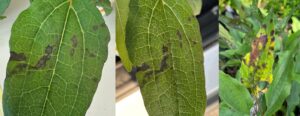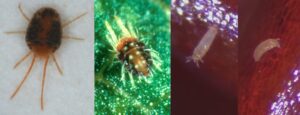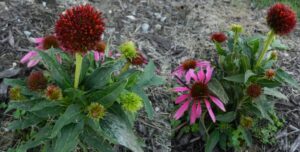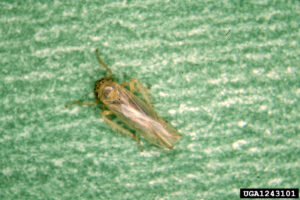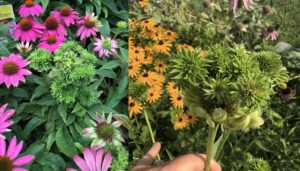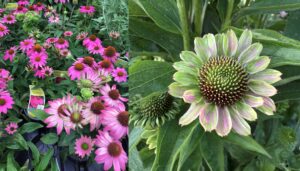Purple coneflower, Echinacea purpurea, is an old native standby that can thrive even in some difficult landscapes. With beautiful purple flowers and the ability to reseed and fill an area, it has been used widely, especially in gardens comprised primarily of native plants; however, they are not without their problems. We sometimes see some fungal leaf spots, including Cercospora leaf spot, which can lead to premature defoliation under humid conditions, but this is more of a problem in nurseries and greenhouses where plants are overcrowded and air flow is restricted (Figure 1). There are two more common and noticeable problems that can affect the overall appearance of the plant and severely affect the flower color and structure: eriophyid mites and aster yellows.
- Figure 1: Echinacea leaves with necrotic angular leaf spots caused by the fungus Cercospora. Photo Credit: PPDL
Eriophyid mites do not look like your typical mite. Most mites have a round body with 4 pairs of legs. Eriophyid mites have elongate, maggot-like bodies with only 2 pairs of legs which are located at the front of their body (Figure 2). While the majority of mites found on plants are very small and often require a hand lens to see, eriophyid mites are smaller still and require a microscope with high magnification to view properly. Eriophyid mites infest and feed on coneflower floral parts, which can cause significant plant stunting and deformation of the flowers, which become small and very spikey (Figure 3). Minor damage may affect the flower scales and disk florets and cause them to be green in color instead of yellow/orange or red. The damage eriophyid mites cause may affect the amount and quality of seeds produced and may lead to reduced reseeding.
- Figure 2: Three different mites. Left: Clover Mite, 4 pairs of legs; Center: European spider mite, 4 pairs of legs; Right: eriophyid mite with 2 pairs of legs and maggot like body. Photo Credit, PPDL and Cliff Sadof
- Figure 3: Echinacea with severe flower stunting and gall-like flower formation due to eriophyid mite feeding. Photo Credit: PPDL
The other coneflower problem we see frequently in the landscape is aster yellows, which is a disease caused by a Phytoplasma spp. and spread by an insect vector, leafhoppers (Figure 4). A phytoplasma is a bacterium that lacks a cell wall and is located only in the phloem of the plant or in its phloem feeding vector, so we cannot find it anywhere else in the environment. Coneflowers infected by Phytoplasma may develop a few different kinds of symptoms: whole plant stunting, phyllody, and virescence. Phyllody is the name of a symptom when vegetative plant parts develop in place of floral parts. This might present as just individual leaves or leaf tissue being produced in the middle of the florets or it might develop into entire stems sprouting from the middle of the flower (Figure 5). Virescence is the name of a symptom when plant parts that are naturally more colorful become green instead. Coloration might appear as a light green cast to the petals, but it might progress into a leaf green color (Figure 6). Damage from eriophyid mites might cause a similar color change, which can make it sometimes hard to distinguish between the two. Like mite damage, since this disease disrupts the normal floral development, it may reduce the potential for plants to reseed.
- Figure 4: Aster Leaf hopper, the vector for aster yellows. Photo Credit: Whitney Cranshaw, Colorado State University, Bugwood.org
- Figure 5: Echinacea infected with aster yellows: example of phyllody, where vegetative tissue develops within floral tissue. Photo Credit: PPDL
- Figure 6: Echinacea infected with aster yellows: example of virescence, where tissue that is normally another color is becoming green. Photo Credit: PPDL
Once a plant is infected with aster yellows, it cannot be cured. Sanitation of affected plants will help remove reservoirs of the pathogen from the area and reduce the potential for leafhoppers to spread it to other healthy plants. The problem is that the Phytoplasma that causes aster yellows can cause disease in over 300 plant species and a large number of different plant families, including vegetable crops (garlic, carrot, celery, etc.). It is possible for the leafhopper vector to come into a new location and spread the pathogen after acquiring it somewhere else. That being said, weeding out perennial weeds may also help reduce possible reservoirs in the landscape. Phytoplasmas will only survive inside the plant tissue, so once the plant tissue is dead and dry or entirely removed, then it cannot be spread by the vector. Managing for the leafhopper is not generally recommended as it does not provide reliable control of the disease.
To determine what pest or pathogen may be present, please consider submitting a sample to the PPDL for diagnosis. While we can look for mites on flower heads, it is important to note that they can be transient and may not be present later, even though the symptoms will remain. Phytoplasmas are obligate pathogens and will only be found in either the host plant or the vector. We are unable to culture it and cannot observe it microscopically, so we must use DNA testing in order to detect it in symptomatic tissue, which typically leads to a higher cost for Phytoplasma testing. We prefer whole plants, where possible, so we can examine everything and collect the appropriate tissue, but the pathogen is primarily located in the phloem, so plant stems and flower stalks are some of the better tissues to submit for testing.
Please contact us at PPDL-samples@purdue.edu, or visit our website https://ag.purdue.edu/department/btny/ppdl/ to reach us.
For additional information:
